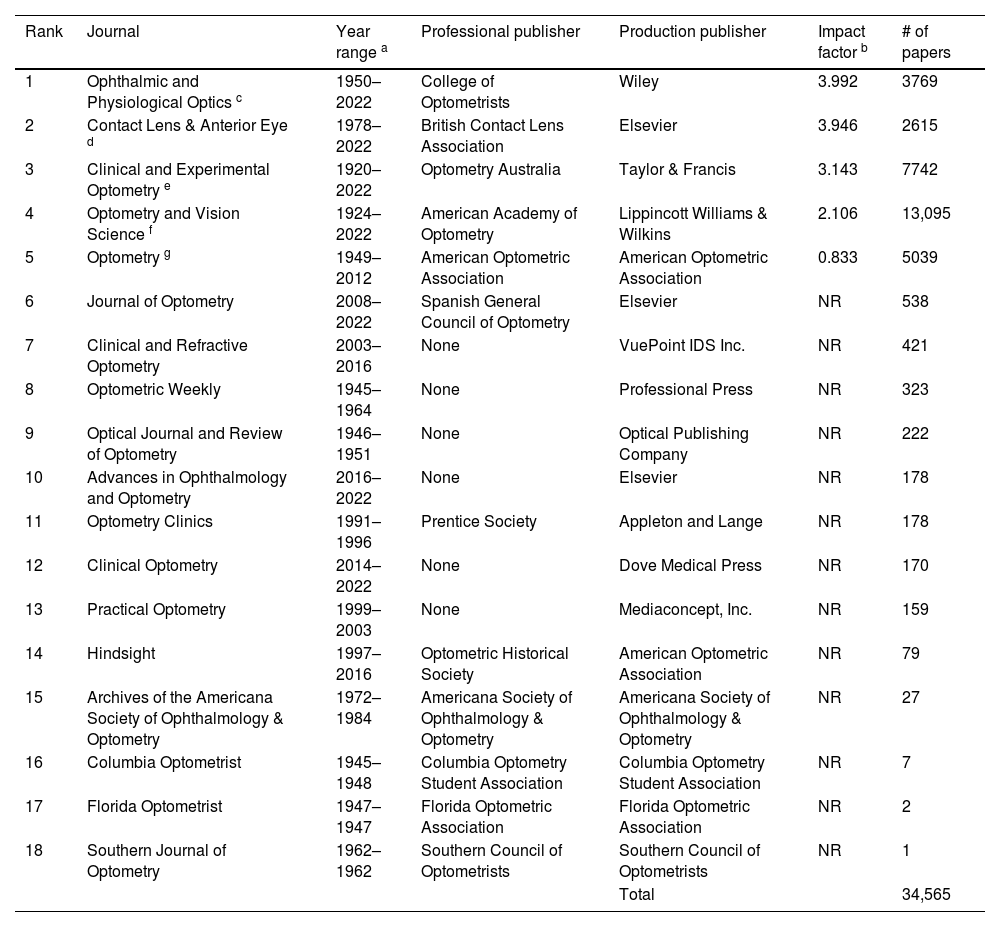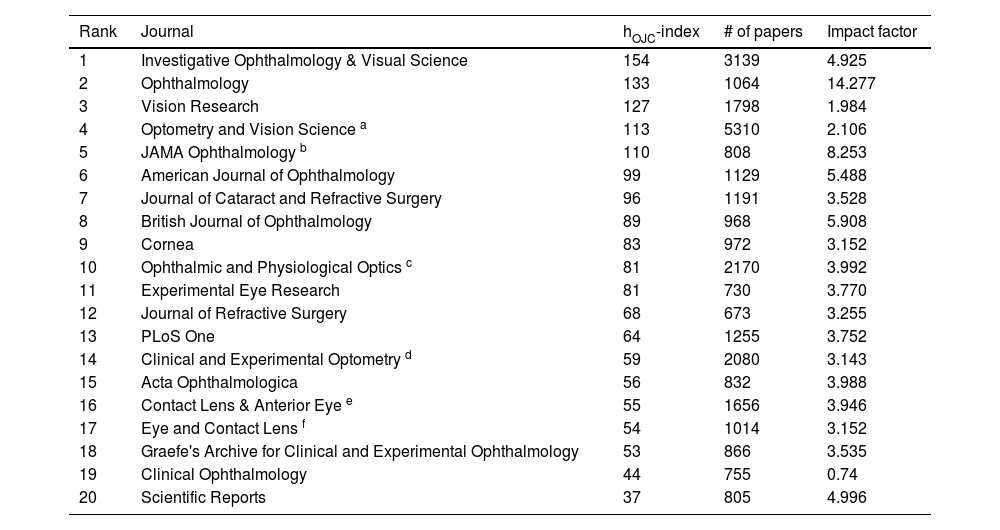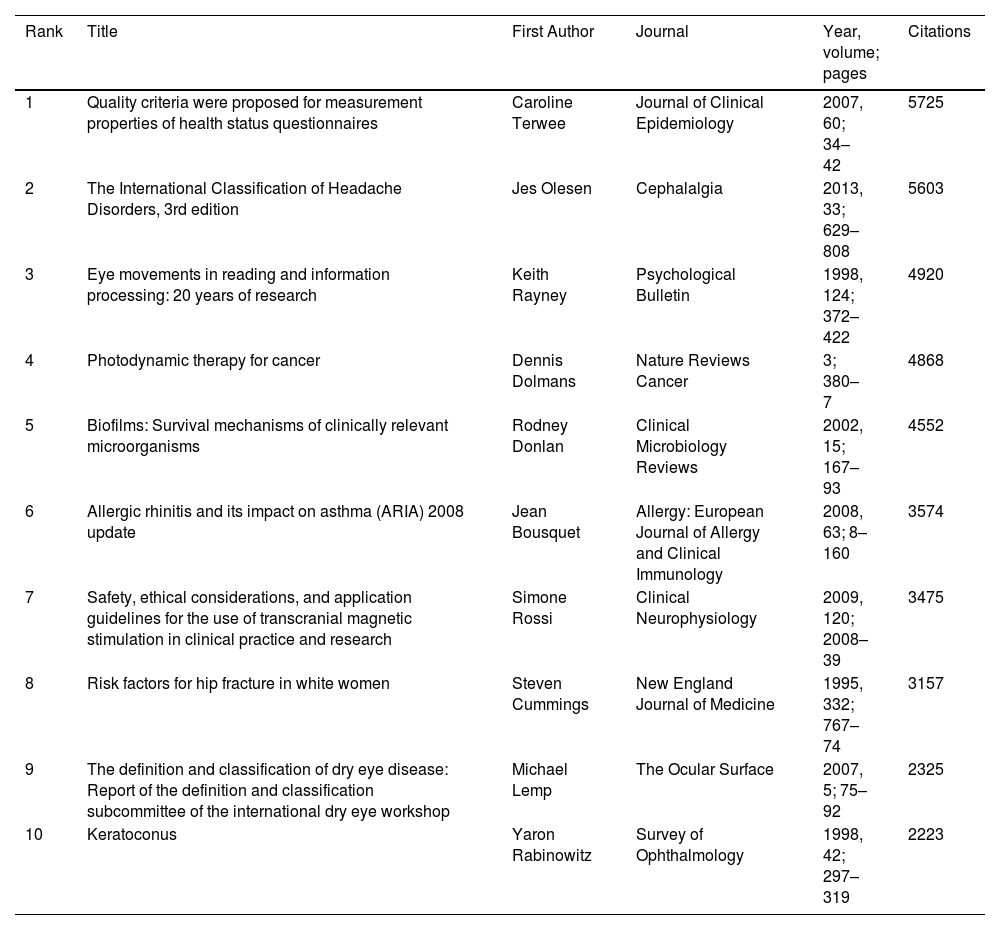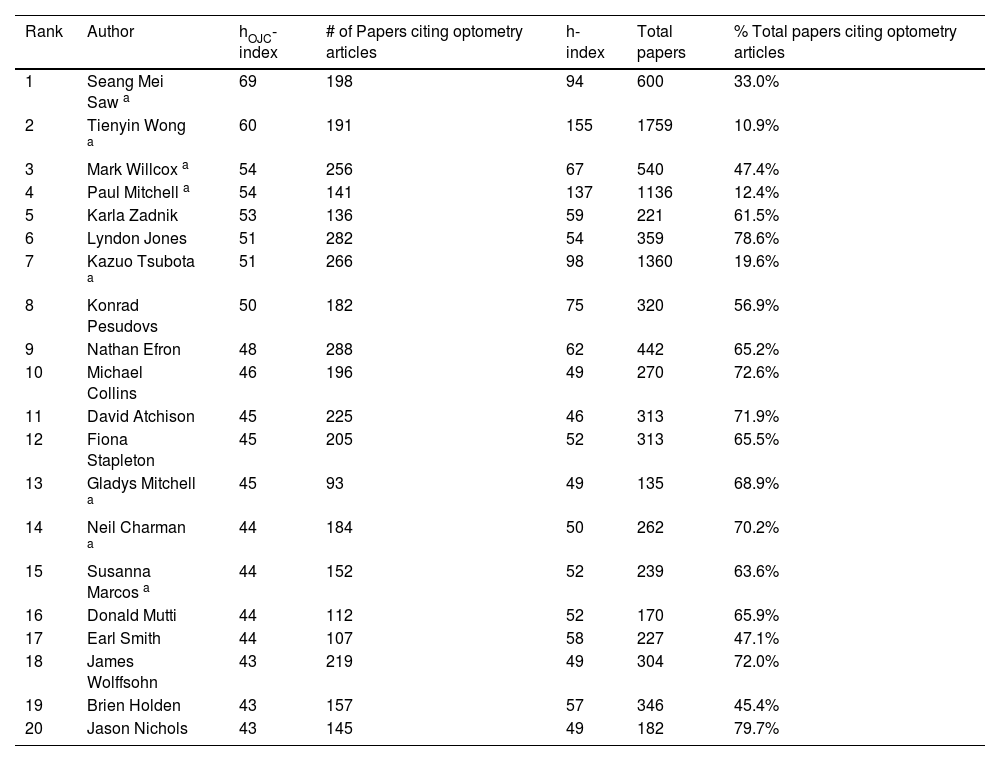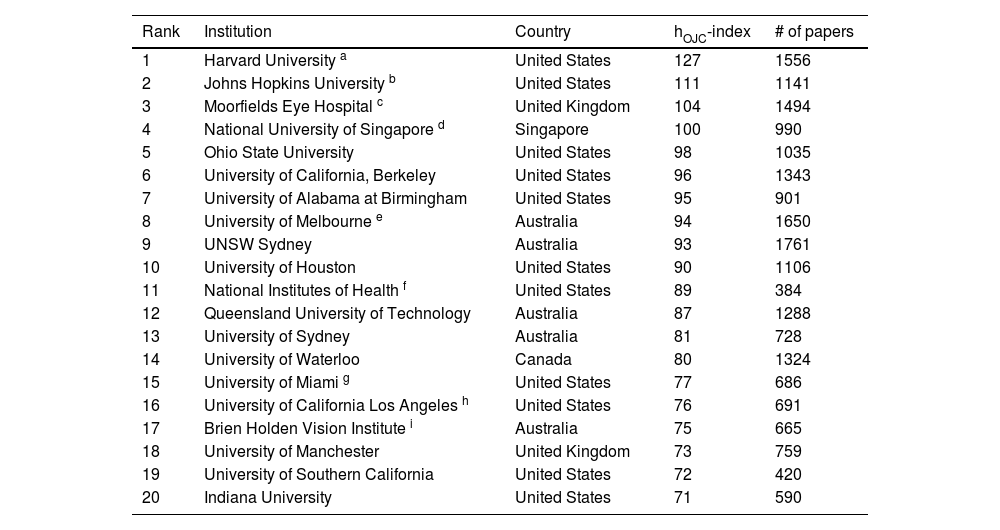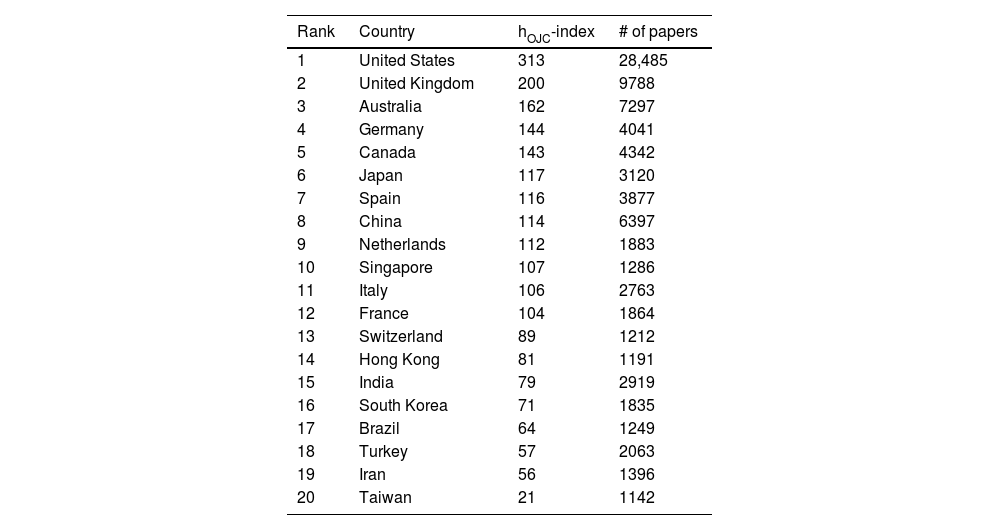This work seeks to identify the most impactful journals, papers, authors, institutions, and countries that cite optometry journal articles.
MethodsThe Scopus database was searched for papers citing at least one article published in any of the 18 optometry journals included in that database (i.e. ‘optometry articles’). The 10 most highly cited papers that cite optometry journal articles were determined from 82,830 papers found. A h-index for “optometry journal citations” (the hOJC-index) was derived for each entity in the categories of journals, papers, authors, institutions and countries to serve as a measure of impact.
ResultsThe hOJC-index of the body of papers citing optometry journal articles is 370. Papers citing optometry journal articles have themselves been cited 2,054,816 times. Investigative Ophthalmology & Visual Science (hOJC = 154) is the most impactful journal citing optometry articles and Optometry and Vision Science the most prolific (5310 papers). The most impactful paper citing optometry journal articles (5725 citations) was published in Journal of Clinical Epidemiology. Ophthalmologist Seang Mei Saw (hOJC = 69) is the most impactful author and optometrist Nathan Efron is the most prolific (288 papers). Harvard University (hOJC = 127) is the most impactful and UNSW Sydney is the most prolific institution (1761 papers). The United States is the most impactful and prolific nation (hOJC = 313; 28,485 papers).
ConclusionsOptometry journal articles are cited extensively by optometrists, ophthalmologists, and vision scientists world-wide, as well as authors from a broad spectrum of non-ophthalmic research domains. This work confirms the utility and influence of optometry journals.
Optometry journals have been published for over a century1; these play an important role in providing an evidence-based rationale for the procedures, techniques and treatment paradigms adopted by clinical optometrists. As well, optometry journals serve as a vehicle for testing information generated by scientists and academics working in the field, disseminating important findings to the optometric research community and beyond, and constitute as a valuable written repository for the work that is undertaken.
Considerable human and physical resources, and significant associated fiscal expenditure, are required to sustain academic journals relating to a small discipline such as optometry, which perhaps raises the question of the value of these journals. The benefits of optometry journals to optometrists in clinical practice are difficult to measure objectively. Much of the evidence reported in optometry journals is eventually adopted by clinicians, whereby 'todays research becomes tomorrows practice' – a still-used theme first adopted in 2003 by the American Academy of Optometry.2 One difficulty that complicates the measurement of clinical impact of research is the time lag of knowledge translation from publication to clinical utilisation, which has been estimated to be around 17 years.3–5
From the perspective of optometric research, the question of value can be addressed by exploring the degree to which the information published in optometry journals is used, where it is used, and the impact of that usage. Examination of journal citations can assist in this regard. All scientific work relies on, and builds upon, previously published literature; invariably, scientific authors cite this literature at the end of papers they write. Modern bibliographic tools are available to search and analyse these citations, thus providing a means of assessing the extent to which specific research papers are valued, as well as the overall impact of a body of literature.6
Taking this a step further, the impact of entities such as journals, authors, institutions, or countries citing a defined body of literature can be evaluated by calculating the h-index7 – a single metric that combines productivity (number of papers) and quality (number of citations). The h-index of an entity is defined as the maximum value of h, whereby an entity has published h papers that have each been cited at least h times.3
The aim of this paper is to determine the extent to which articles published in optometry journals (referred to throughout this paper as ‘optometry articles’) are cited as a whole, and then to drill down to determine the most impactful papers and authors citing optometry articles, as well as the most impactful journals, institutions, and countries that cite the optometry journal literature. This will provide a quantitative assessment of the impact of optometry journals.
Materials and methodsSearch protocolA preliminary search was undertaken to find all optometry journals in the Scopus database (Elsevier). 'Optometric journals' were defined as journals with ‘optometry’, ‘optometric’ or ‘optometrist’ in the title, as well as journals that do not have the stem ‘optom’ in the title, but are principally organized by the optometric profession or a primarily optometric organization. Eighteen optometry journals were found; these are listed in Table 1, ranked in order of impact factor for year 2021 (Clarivate8), then the total number of papers for that journal on the Scopus database.
Optometric journals found in the Scopus database, ranked by impact factor then number of papers.
| Rank | Journal | Year range a | Professional publisher | Production publisher | Impact factor b | # of papers |
|---|---|---|---|---|---|---|
| 1 | Ophthalmic and Physiological Optics c | 1950–2022 | College of Optometrists | Wiley | 3.992 | 3769 |
| 2 | Contact Lens & Anterior Eye d | 1978–2022 | British Contact Lens Association | Elsevier | 3.946 | 2615 |
| 3 | Clinical and Experimental Optometry e | 1920–2022 | Optometry Australia | Taylor & Francis | 3.143 | 7742 |
| 4 | Optometry and Vision Science f | 1924–2022 | American Academy of Optometry | Lippincott Williams & Wilkins | 2.106 | 13,095 |
| 5 | Optometry g | 1949–2012 | American Optometric Association | American Optometric Association | 0.833 | 5039 |
| 6 | Journal of Optometry | 2008–2022 | Spanish General Council of Optometry | Elsevier | NR | 538 |
| 7 | Clinical and Refractive Optometry | 2003–2016 | None | VuePoint IDS Inc. | NR | 421 |
| 8 | Optometric Weekly | 1945–1964 | None | Professional Press | NR | 323 |
| 9 | Optical Journal and Review of Optometry | 1946–1951 | None | Optical Publishing Company | NR | 222 |
| 10 | Advances in Ophthalmology and Optometry | 2016–2022 | None | Elsevier | NR | 178 |
| 11 | Optometry Clinics | 1991–1996 | Prentice Society | Appleton and Lange | NR | 178 |
| 12 | Clinical Optometry | 2014–2022 | None | Dove Medical Press | NR | 170 |
| 13 | Practical Optometry | 1999–2003 | None | Mediaconcept, Inc. | NR | 159 |
| 14 | Hindsight | 1997–2016 | Optometric Historical Society | American Optometric Association | NR | 79 |
| 15 | Archives of the Americana Society of Ophthalmology & Optometry | 1972–1984 | Americana Society of Ophthalmology & Optometry | Americana Society of Ophthalmology & Optometry | NR | 27 |
| 16 | Columbia Optometrist | 1945–1948 | Columbia Optometry Student Association | Columbia Optometry Student Association | NR | 7 |
| 17 | Florida Optometrist | 1947–1947 | Florida Optometric Association | Florida Optometric Association | NR | 2 |
| 18 | Southern Journal of Optometry | 1962–1962 | Southern Council of Optometrists | Southern Council of Optometrists | NR | 1 |
| Total | 34,565 |
NR = not ranked.
Range of years of papers for each included in the Scopus database, which in many instances is less than the full year range for the journal.
Calculated for year 2021, except for the journal ‘Optometry’, which is calculated for year 2012 (final year of publication).
A search term was derived to interrogate the Scopus database and find all articles published between January 1, 1970, and September 25, 2022, that cited at least one paper from any of the 18 optometry journals listed on that database (spanning from 1920 to the present time; see Table 1). This search term used journal International Standard Serial Numbers (ISSN) or source titles. The search criteria were refined through several iterations, resulting in the following equation being derived: (ref ISSN (1040-5488) OR ref ISSN (0275-5408) OR ref ISSN (0816-4622) OR ref ISSN (0003-0244) OR ref ISSN (0817-881x) OR ref ISSN (1888-4296) OR ref ISSN (1705-4850) OR ref ISSN (1050-6918) OR ref ISSN (1529-1839) OR ref ISSN (0141-7037) OR ref ISSN (1444-0938) OR ref ISSN (0093-7002) OR ref ISSN (13670484) OR ref ISSN (0007-1218)) OR REFSRCTITLE (optomet*) OR REFSRCTITLE (hindsight AND saint AND louis AND mo) OR REFSRCTITLE (international AND contact AND lens AND clinic) AND (EXCLUDE (SRCTYPE, “b”) OR EXCLUDE (SRCTYPE, “Undefined”)) AND (EXCLUDE (DOCTYPE, “ch”) OR EXCLUDE (DOCTYPE, “bk”)) AND (LIMIT-TO (LANGUAGE, “English”))
Supplementary information included in this paper, such as the year range of publication of journals, professional and production publishers of journals, professional background of authors and organisational arrangements of institutions in respect of optometry schools, was determined by searching the internet for websites of the journals, authors and institutions of interest.
Assessing impactA h-index for “optometry journal citations” (the “hOJC-index”) was derived, to serve as a measure of the impact of the search result across journals, authors, institutions, and countries. This technique has been used extensively by the current authors.9–12 In brief, the hOJC-index of a given entity was determined by sorting the subset of optometry articles for that entity by rank order of citations to those articles (from highest to lowest) and working down the list, starting with the article that had the highest number of citations, to determine the article with a rank number that was larger than its number of citations. Taking the example of 'authors', the hOJC-index for that author was identified as the number of the entry above the identified article. This was repeated for each of the 100 most prolific authors of optometry articles; the top 20 were then identified and ranked in order of hOJC-index. The same approach was applied to identify the most impactful journals, institutions and countries that cite optometry articles.
ResultsThe search revealed that 82,830 papers have referenced optometry articles; these papers have in turn been cited a total of 2,054,816 times. The combined hOJC-index of this body of work is 370. A total of 13.9% of papers referencing optometry articles have received no citations.
The time course of publication of the papers referencing optometry articles from 1970 to September 25, 2022 – is shown in Fig. 1. It is evident from this graph is that there has been a steady increase in the output of papers referencing optometry articles to over 6000 papers per year at the present time.
Most impactful journals citing optometry articlesThe top 20 journals in the Scopus database which cite optometry articles are listed in Table 2 in rank order of hOJC-indices, which range from 37 to 154. These top 20 journals can be categorised as: ophthalmology – 11; optometry – 4; vision science – 3; and general science – 2.
Most impactful journals referencing optometry articles, ranked by journal hOJC, then number of papers.
| Rank | Journal | hOJC-index | # of papers | Impact factor |
|---|---|---|---|---|
| 1 | Investigative Ophthalmology & Visual Science | 154 | 3139 | 4.925 |
| 2 | Ophthalmology | 133 | 1064 | 14.277 |
| 3 | Vision Research | 127 | 1798 | 1.984 |
| 4 | Optometry and Vision Science a | 113 | 5310 | 2.106 |
| 5 | JAMA Ophthalmology b | 110 | 808 | 8.253 |
| 6 | American Journal of Ophthalmology | 99 | 1129 | 5.488 |
| 7 | Journal of Cataract and Refractive Surgery | 96 | 1191 | 3.528 |
| 8 | British Journal of Ophthalmology | 89 | 968 | 5.908 |
| 9 | Cornea | 83 | 972 | 3.152 |
| 10 | Ophthalmic and Physiological Optics c | 81 | 2170 | 3.992 |
| 11 | Experimental Eye Research | 81 | 730 | 3.770 |
| 12 | Journal of Refractive Surgery | 68 | 673 | 3.255 |
| 13 | PLoS One | 64 | 1255 | 3.752 |
| 14 | Clinical and Experimental Optometry d | 59 | 2080 | 3.143 |
| 15 | Acta Ophthalmologica | 56 | 832 | 3.988 |
| 16 | Contact Lens & Anterior Eye e | 55 | 1656 | 3.946 |
| 17 | Eye and Contact Lens f | 54 | 1014 | 3.152 |
| 18 | Graefe's Archive for Clinical and Experimental Ophthalmology | 53 | 866 | 3.535 |
| 19 | Clinical Ophthalmology | 44 | 755 | 0.74 |
| 20 | Scientific Reports | 37 | 805 | 4.996 |
Includes American Journal of Optometry and Physiological Optics, American Journal of Optometry and Archives of American Academy of Optometry, Optometry and Vision Science Official Publication of the American Academy of Optometry, and America Journal of Optometry and Archives of American Academy of Optometry.
Includes British Journal of Physiological Optics and Ophthalmic Physiological Optics – The Journal of the British College of Ophthalmic Opticians Optometrists.
The six highest ranking journals in Table 2 are published in the United States. The three highest ranked journals are not optometric; these are Investigative Ophthalmology & Visual Science (hOJC = 154), Ophthalmology (hOJC = 133) and Vision Research (hOJC = 127). The highest performing optometric journal, at rank #4, is Optometry and Vision Science (hOJC = 113), with the other four optometry journals ranking #10, #14 and #16.
The journals that have published the highest number of papers citing optometry articles are: Optometry and Vision Science – 5310 papers; Investigative Ophthalmology & Visual Science – 3139; Ophthalmic and Physiological Optics – 2170; and Clinical and Experimental Optometry – 2080.
Most impactful papers citing optometry articlesThe top 10 most impactful papers citing optometry articles are shown in Table 3. These papers have been cited between 2223 and 5725 times. The most highly cited paper referencing optometry articles (5725 citations) is by Terwee et al., entitled ‘Quality criteria were proposed for measurement properties of health status questionnaires’, and published in Journal of Clinical Epidemiology. Only one of the 52 references in this paper was to an article in an optometric journal – Ophthalmic and Physiological Optics.
Most impactful papers referencing optometry articles, ranked by number of citations.
One of the 10 most impactful papers citing optometry articles presented in Table 3 was published in a vision science journal (The Ocular Surface), one appeared in an ophthalmology journal (Survey of Ophthalmology), and the rest appeared in a diverse array of journals, from the fields of epidemiology, psychology, oncology, allergy, neurology, neurophysiology, and general medicine.
Most impactful authors of papers citing optometry articlesThe 20 most impactful authors of papers citing optometry articles are presented in Table 4 and have hOJC-indices ranging from 43 to 69. The academic qualifications of these top 20 authors are: optometrist – 12; ophthalmologist – 4; optical physicist – 2; biostatistician – 1; and microbiologist – 1.
Most impactful authors referencing optometry articles, ranked by journal hOJC, then number of papers.
| Rank | Author | hOJC-index | # of Papers citing optometry articles | h-index | Total papers | % Total papers citing optometry articles |
|---|---|---|---|---|---|---|
| 1 | Seang Mei Saw a | 69 | 198 | 94 | 600 | 33.0% |
| 2 | Tienyin Wong a | 60 | 191 | 155 | 1759 | 10.9% |
| 3 | Mark Willcox a | 54 | 256 | 67 | 540 | 47.4% |
| 4 | Paul Mitchell a | 54 | 141 | 137 | 1136 | 12.4% |
| 5 | Karla Zadnik | 53 | 136 | 59 | 221 | 61.5% |
| 6 | Lyndon Jones | 51 | 282 | 54 | 359 | 78.6% |
| 7 | Kazuo Tsubota a | 51 | 266 | 98 | 1360 | 19.6% |
| 8 | Konrad Pesudovs | 50 | 182 | 75 | 320 | 56.9% |
| 9 | Nathan Efron | 48 | 288 | 62 | 442 | 65.2% |
| 10 | Michael Collins | 46 | 196 | 49 | 270 | 72.6% |
| 11 | David Atchison | 45 | 225 | 46 | 313 | 71.9% |
| 12 | Fiona Stapleton | 45 | 205 | 52 | 313 | 65.5% |
| 13 | Gladys Mitchell a | 45 | 93 | 49 | 135 | 68.9% |
| 14 | Neil Charman a | 44 | 184 | 50 | 262 | 70.2% |
| 15 | Susanna Marcos a | 44 | 152 | 52 | 239 | 63.6% |
| 16 | Donald Mutti | 44 | 112 | 52 | 170 | 65.9% |
| 17 | Earl Smith | 44 | 107 | 58 | 227 | 47.1% |
| 18 | James Wolffsohn | 43 | 219 | 49 | 304 | 72.0% |
| 19 | Brien Holden | 43 | 157 | 57 | 346 | 45.4% |
| 20 | Jason Nichols | 43 | 145 | 49 | 182 | 79.7% |
The most impactful author of papers citing optometry articles is ophthalmologist Seang Mei Saw (hOJC = 69). None of the top 4 authors are optometrists; the highest-ranking optometrists are Karla Zadnik (rank #5; hOJC = 53) followed by Lyndon Jones (rank #6, hOJC = 51).
The two most prolific authors of papers citing optometry articles in the top 20 are optometrists Nathan Efron (n = 288 papers) and Lyndon Jones (n = 282). Microbiologist Mark Willcox (n = 256) is at rank #3. The top 20 authors who have published the highest percentage of papers citing optometry articles as a function of their total paper output are optometrists Jason Nichols (80%), Lyndon Jones (79%) and Michael Collins (73%).
Five (25%) of the top 20 most impactful authors of papers citing optometry articles are female: ophthalmologist Seang Mei Saw (hOJC = 69), optometrists Karla Zadnik (hOJC = 53) and Fiona Stapleton (hOJC = 45), biostatistician Gladys Mitchell (hOJC = 45) and optical physicist Susanna Marcos (hOJC = 44).
Most impactful institutions producing papers that cite optometry articlesThe top 20 institutions producing papers that cite optometry articles are listed in Table 5. The hOJC-indices of these institutions range from 71 to 127. The top-ranking institution is Harvard University, United States (hOJC = 127), followed by Johns Hopkins University, United States (hOJC = 111) and Moorfields Eye Hospital, United Kingdom (hOJC = 104). Thirteen of the top 20 institutions are home to optometry schools; of these, Ohio State University has the highest ranking (#5) (hOJC = 98). It should be noted that many of these institutions with optometry schools house ophthalmology academic units, which also contribute to these metrics.
Most impactful institutions referencing optometry articles, ranked by journal hOJC.
| Rank | Institution | Country | hOJC-index | # of papers |
|---|---|---|---|---|
| 1 | Harvard University a | United States | 127 | 1556 |
| 2 | Johns Hopkins University b | United States | 111 | 1141 |
| 3 | Moorfields Eye Hospital c | United Kingdom | 104 | 1494 |
| 4 | National University of Singapore d | Singapore | 100 | 990 |
| 5 | Ohio State University | United States | 98 | 1035 |
| 6 | University of California, Berkeley | United States | 96 | 1343 |
| 7 | University of Alabama at Birmingham | United States | 95 | 901 |
| 8 | University of Melbourne e | Australia | 94 | 1650 |
| 9 | UNSW Sydney | Australia | 93 | 1761 |
| 10 | University of Houston | United States | 90 | 1106 |
| 11 | National Institutes of Health f | United States | 89 | 384 |
| 12 | Queensland University of Technology | Australia | 87 | 1288 |
| 13 | University of Sydney | Australia | 81 | 728 |
| 14 | University of Waterloo | Canada | 80 | 1324 |
| 15 | University of Miami g | United States | 77 | 686 |
| 16 | University of California Los Angeles h | United States | 76 | 691 |
| 17 | Brien Holden Vision Institute i | Australia | 75 | 665 |
| 18 | University of Manchester | United Kingdom | 73 | 759 |
| 19 | University of Southern California | United States | 72 | 420 |
| 20 | Indiana University | United States | 71 | 590 |
UNSW Sydney, Australia, has produced the highest number of papers citing optometry articles (n = 1761), with the University of Melbourne, Australia ranked #2 (n = 1650).
The number of institutions from the various countries represented in Table 5 are: United States – 11; Australia – 5; United Kingdom – 2; Singapore – 1; and Canada – 1.
Most impactful countries producing papers that cite optometry articlesThe 20 most impactful countries producing papers that cite optometry articles are listed in Table 6. The hOJC-indices of the countries listed range from 21 to 313, and the paper count from 1142 to 28,485. The United States is the most impactful and prolific nation producing papers that cite optometry journals (hOJC = 313; n = 28,485) – having a substantially greater hOJC-index, and producing almost three times as many papers, as #2 ranked United Kingdom (hOJC = 200; n = 9788).
Most impactful countries referencing optometry articles, ranked by journal hOJC.
The use of citation metrics to assess research impact does not have universal acceptance. The underlying assumption is that there is a direct association between the number of citations and the quality of the work, a view which is strongly supported by some bibliometric researchers,13 although disputed by others.14 Notwithstanding this difference of opinion, citation analysis is generally considered to be a useful objective tool for evaluating the impact of scholarly articles, and by extension, the impact of the authors, journals, institutions and countries generating these works.
The increase in the number of papers citing optometry journals over the past half-century, as depicted in Fig. 1, and the substantial impact of this body of work as described above, is evidence of the growing value of optometry journals – not just to optometry, but the broader scientific fraternity that relies upon optometric research to support its own scientific advancements.
Most impactful journals citing optometry articlesIt is not surprising that 15 of the top 20 journals (75%) are ophthalmic (i.e., 11 ophthalmology and 4 optometry journals). In any field of research, authors tend to cite papers that in some way support the work that is being reported, which therefore would be primarily derived from the literature base underpinning that field. The authors found 202 non-disambiguated ophthalmology journal names on the Scopus database, compared to 18 disambiguated optometry journal names. Therefore, given the substantial overlap in the subject matter reported by optometry and ophthalmology journals, it is not unexpected that almost three times as many ophthalmology journals cite optometry articles than optometry journals. These citation statistics demonstrate that optometry journals do not exist for the exclusive advancement of optometric science and the optometric profession; optometry journals are also used extensively and valued by ophthalmology researchers, in addition to vision scientists and general medical researchers.
A total of 5310 papers in Optometry and Vision Science have cited optometry articles, which is considerably greater than second-ranked Investigative Ophthalmology & Visual Science (3139 papers). However, optometry article-citing papers published by Optometry and Vision Science (hOJC = 113) are less impactful than those published by Investigative Ophthalmology & Visual Science (hOJC = 154). The likely reason for this is that a substantial proportion of the papers published in Optometry and Vision Science, especially during the first 40 years of publications of that journal (say, 1924 to the 1960s), were editorials, professional commentaries, and clinical material such as case reports – material that tends not to be cited extensively. Conversely, Investigative Ophthalmology & Visual Science was established more recently (1962) as a 'science only' journal, and as such has generally publishes work that is more likely to be cited. The readership of Investigative Ophthalmology & Visual Science is also presumably much larger than that of Optometry and Vision Science.
Most impactful papers citing optometry journalsThe broad spectrum of fields reflected amongst the most highly cited papers displayed in Table 3 reinforces the notion that the optometry literature has value far beyond the ophthalmic domain. The 10 leading papers that cite optometry articles are themselves highly impactful, having been cited between 2000 and 6000 times. The impact of such publications can be appreciated when considering that only 0.03% of scientific papers have been cited more than 1000 times.15
Although 82,830 papers are known to have cited optometry articles, only 13.9% of these papers have never been cited themselves, attesting to the overall quality and impact of papers citing optometry articles. The balance of these papers has been cited over 2 million times, further demonstrating the importance of those works, and by extension their value in developing ideas or verifying factual information relating to vision science and beyond.
Most impactful authors of papers citing optometry articlesThe most impactful author of publications citing optometry articles is Seang Mei Saw (hOJC = 69), who is professor of ophthalmology at the National University of Singapore. She holds a joint appointment at the Saw Swee Hock School of Public Health, and in that position has conducted several large-scale epidemiologic studies on myopia in children, as principal investigator. Given that the field of refractive error has always been a core area of optometric research and clinical practice,11 Professor Saw would have found it necessary to cite optometry articles extensively to support her writings. As an ophthalmologist, much of her work would be published in ophthalmology journals, which are known to generally have higher impact than optometry journals, hence the high impact of the papers authored by Professor Saw which cite optometry articles. For similar reasons, ophthalmologists Tienyin Wong (hOJC = 60) and Paul Mitchell (hOJC = 54) are ranked #2 and #4.
The last column in Table 4 shows, for each author, the proportion of papers citing optometry articles as a function of all papers published by that author. For the four ophthalmologists listed in this table (Seang Mei Saw, Tienyin Wong, Paul Mitchell and Kazuo Tsubota), none of whom work in university optometry departments, this proportion ranges from 12.4% to 33.0%. For the other 16 authors in Table 4, all of whom work in university optometry departments, the proportion ranges from 45.4% to 79.7%. This observation supports the notion that authors working in a given field are more likely to cite articles from journals relating to that field.
The countries where the top 20 authors have spent most or all of their academic careers are: Australia – 8; USA – 7; UK – 2; Canada – 1; Japan – 1; and Singapore – 1.
Most impactful institutions and countries producing papers that cite optometry articlesThe four highest ranking institutions listed in Table 5 are the home of world-renowned ophthalmology departments, hospitals, or eye institutes. Much of the research generated by these institutions, which cites optometry articles, is typically published in high impact ophthalmology journals.
The United States is the leading country for life sciences research,16 which is consistent with this nation producing papers of the highest impact, and the greatest volume of papers, that cite optometry articles.
Comparison with other disciplinesThe volume of the body of papers citing optometry articles (82,830) and the associated measure of impact of these papers (hOJC = 370) can be compared with other disciplines by undertaking crude searches in Scopus. Articles published in dentistry journals been cited by a similar number of papers (80,101) to that of optometry; however, papers citing dentistry articles are less impactful (hOJC = 316) than those of optometry. The body of papers citing articles published in veterinary medicine journals is less extensive (42,208 papers) and less impactful (hOJC = 187) than that for optometry. The higher impact of papers citing optometry articles compared with papers citing dentistry or veterinary medicine articles is not related to the relative size of these professions; for example, there are approximately 165,000 dentists, 120,000 veterinarians and 40,000 optometrists in the United States. Given that citation metrics generally correlate with the size and reach of a discipline,17 the above comparisons could suggest that optometry journals that underpin the practice of optometry are disproportionately more valuable than those supporting dentistry or veterinary science.
ConclusionsOptometry journals are cited extensively by optometrists, ophthalmologists, and vision scientists world-wide, as well as authors from a broad spectrum of non-ophthalmic research domains. That around 6000 scientific papers citing optometry articles are published annually is an indication of the intrinsic value of the information generated by optometry journals, in a sense providing a raison d'être for the very existence of optometry journals and a justification for the ongoing support to publish such journals by optometric professional organisations.
This research did not receive any specific grant from funding agencies in the public, commercial, or not-for-profit sectors.
This research did not receive any specific grant from funding agencies in the public, commercial, or not-for-profit sectors.




